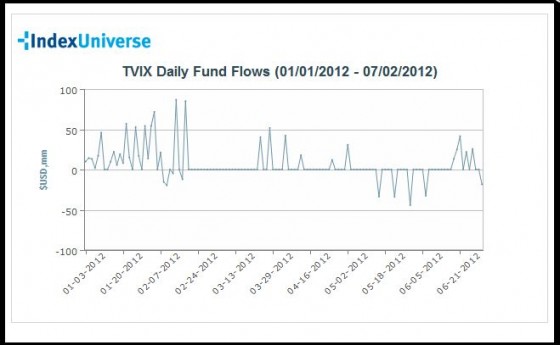Update
TVIX is alive, and well. For information about TVIX’s reverse stock splits see this post
————————————-.
Things have not been well with TVIX since Feb 21st, 2012 when Credit Suisse stopped the share creation process. In late March 2012, a modified creation process was put in place, but that has only been partially successful—the TVIX price has often been floating 5% to 10% above its Indicative Value (IV). This is much better than the 90% premium we saw in early March, but it’s still not good. The IV tracks the underlying index that exchanged traded products (ETP) are designed to follow. TVIX’s competitor, ProShares UVXY for example usually trades within 1% of its IV value.
When Credit Suisse pulled the plug on share creations they cited “internal limits” as the reason. The chart below from the Index Universe ETF Fund Flow Tool shows TVIX’s inflow/outflows in 2012.

In January and February TVIX had net inflows of $642 million dollars as its volume increased to surpass Barclays’ VXX as the volume leader in volatility ETPs. Normally this would be great news, but with a 2X leveraged fund like TVIX there’s a not so pleasant obligation that comes with growth. In order for a 2X leveraged fund to maintain its leverage factor it needs to adjust its market exposure every day. If the daily value of the underlying index (SPVXSTR in this case) goes up 10%, then Credit Suisse must increase its investment by 20% of the fund’s assets under management (AUM) that same day. See Under the Hood of a Leveraged ETP for an example of how this works with leveraged and inverse funds.
Volatility indexes tend to be…well, volatile. In the last six years SPVXSTR experienced daily spikes of 24%, 21%, 20%, 19%, and three of 14%. If there was another worst case jump of 24% in the SPVXSTR index (27-Feb-07) Credit Suisse would need to invest an additional 48% of the current assets of the fund to maintain the 2X leverage factor. With AUM of $690 million (22-Feb-2012 actual), this would require a $330 million incremental investment at market close to rebalance the fund. And of course, volatility begets volatility so the next day’s jump could be similar or worse.
With TVIX’s AUM nearing $700 million and growing rapidly it’s not shocking that Credit Suisse pulled the plug on creations to put a lid on this exposure.
Some people have speculated that Credit Suisse balked because traders were front-running the big end of day VIX Futures buy/sells associated with daily rolls and rebalancing. I don’t think this is a factor—Credit Suisse doesn’t care what SPXVSTR closes at, as long as their funds track it they’re happy.
I think the underlying problem that spooked Credit Suisse was the credit risk of the swaps that are used to hedge their positions. My understanding is that volatility ETN vendors like Credit Suisse typically don’t directly manage the nuts and bolts of index hedging, instead, they outsource that function to 3rd parties via volatility or variance swaps.
That’s ok until a 3rd party defaults on a swap—then the heat is on Credit Suisse. Since ETNs are senior notes Credit Suisse is obligated to honor them—or go bankrupt. I don’t see a mechanism for passing those losses directly to the TVIX shareholders via the share price.
When faced with risks of this magnitude Credit Suisse wanted lower risk swaps—which are naturally more expensive. Rather than absorb these costs internally, which would likely have rendered TVIX unprofitable, they opted to push the problem onto the market makers.
So when Credit Suisse resumed share creation they added this language regarding hedging instruments, which includes swaps, to their prospectus:
“…will be on terms acceptable to Credit Suisse, including the counterparty meeting Credit Suisse’s creditworthiness requirements, margin requirements, minimum size and duration requirements and such other terms as Credit Suisse deems appropriate in its sole discretion.”
Apparently, these terms are expensive enough that market makers can only profitably create shares if TVIX is trading 5% to 10% above its IV price. This is a bad situation because TVIX can fluctuate between its IV value and 10% above for no reason.
So how does ProShares’ UVXY, an Exchange Traded Fund (ETF) which offers the same 2X leverage on short term volatility deal with credit risk? ETFs don’t do internal hedging, they always require the market makers to provide the underlying securities/hedges in exchange for new shares. Swap defaults are a possibility for ETFs too, but if it occurs it will be reflected in the share price. To reduce this risk ProShares requires daily marked to market collateral and only works with large, well-capitalized, well established financial institutions like Deutsche Bank, UBS, and Goldman Sachs.
But the bottom line is that the shareholder takes the default risk, not the ETF. For more on ETF/ETN credit risk see this post.
If Credit Suisse has not figured out how to fix TVIX so that it tracks its index acceptably, they might want it to go away. They can do this by doing nothing.
Without frequent reverse stock splits, TVIX would be eroded down towards zero by contango. If there aren’t any significant volatility spikes TVIX tends to decay around 90% per year, so it wouldn’t take too long before it started trading below $1. My understanding is that because TVIX is based on futures it may not be subject to the NYSE delisting rules, but at sub-dollar prices it is not a mainstream product.
Fade to black.


CS is exiting the ETF business. They probably are not very motivated to put any efforts into it.